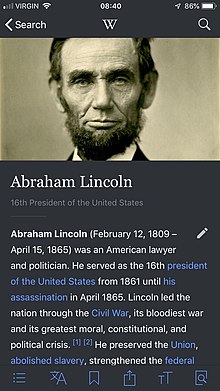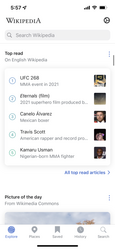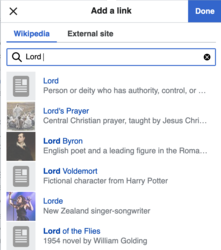विकिपीडिया:Short description
|
|
यह एक सूचना पृष्ठ है यह विकिपीडिया के मानदंडों और प्रथाओं के कुछ पहलू या पहलुओं पर संपादन समुदाय की सर्वसम्मति का वर्णन करता है. यह विकिपीडिया की नीतियाँ और दिशानिर्देश नही है, क्योंकि इसे पारित नही किया गया है. |
|
|
|
ये पन्ना छोटे शब्दों में: With the exception of articles for which the title is sufficient to fully describe the article, each Wikipedia article should include a concise explanation of its scope in the form of a short description in a specific format. These descriptions appear in Wikipedia mobile and some desktop searches, and help users identify the desired article. |

The short description of a Wikipedia article or of another namespace page is a concise explanation of the scope of the page. These descriptions appear in Wikipedia mobile and some desktop searches,[note 1] and help users identify the desired article. When viewing an article, some mobile Wikipedia apps also display the description below the page title.
Short descriptions do not appear by default when viewing an article in desktop view, but logged-in users who wish to see and edit them can do so easily by enabling the Shortdesc helper in their Preferences "gadgets".
Purposes
[संपादित करें]Short descriptions provide:
- a very brief indication of the field covered by the article
- a short descriptive annotation
- a disambiguation in searches, especially to distinguish the subject from similarly titled subjects in different fields
| Examples of short description use | ||||||
|---|---|---|---|---|---|---|
|
Short descriptions are also used as annotations in lists of links, such as "See also" sections and Index list articles, where they provide some context for the link when a local annotation is not provided. The template {{Annotated link}} is available for this purpose.
Pages that should have a short description
[संपादित करें]All mainspace articles should have a short description (including those that are intentionally blank; see below). Redirects and most pages outside the mainspace do not normally need a description, although one may be added in the rare cases it would be useful.
The short description may appear directly in the wikicode for the page, via the साँचा:Txl template, or may be transcluded automatically from a template such as an infobox. Disambiguation pages and list articles both make use of transcluded descriptions, and those do not normally need to be edited manually.
Content
[संपादित करें]The short description is part of the article content, and is subject to the normal rules on content, including Neutral point of view and Biographies of living persons. The normal editing rules such as Consensus and the Editing policy also apply.
Editors should keep in mind that short descriptions are meant to distinguish an article from similarly named articles in search results, and not to define the subject. Each description should provide a brief overview of the topic, a short annotation, and a way to differentiate it from other similarly titled articles.
Ideally, each page should have its own purpose-written short description. While the Shortdesc helper tool allows text to be imported from Wikidata, this should be done with caution as Wikidata descriptions do not follow Wikipedia policies and may be too long or too technical to be used as a short description. It is the editor's responsibility to ensure the short description is appropriate, accurate and compliant with Wikipedia's policies, particularly for biographies of living people and for medical articles.
Content text
[संपादित करें]When visible on desktop or mobile, the short description immediately follows the article title, and should be comprehensible in that location.
A short description is not a definition, and editors should not attempt to define the article's subject nor to summarise the lead. There is no objection to an otherwise-suitable short description that also happens to work as a definition.
As far as possible, it should:
- focus on the purposes stated above
- start with the most important information (mobile applications may truncate long descriptions)
- use universally accepted facts that will not be subject to rapid change, avoiding anything that could be understood as controversial, judgemental, or promotional
- avoid jargon, and use simple, readily comprehensible terms that do not require pre-existing detailed knowledge of the subject
- avoid duplicating information that is already in the title (but don't worry too much if you need to repeat a word or two for context)
- avoid time-specific adjectives like "former", "retired", "late", "defunct", "closed", "current", "new", "recent", "planned", "future", etc.
- avoid subjective adjectives like "small", "famous", "popular"
Formatting
[संपादित करें]
Each short description should:
- be written in plain text – without HTML tags, wiki markup, typographic dingbats, emojis, or CSS display manipulation
- start with a capital letter [note 2]
- avoid initial articles (A, An, The) except when required for correct grammar and meaning
- avoid using a final full stop (period)
- be short – no longer than is needed to fulfill its functions effectively
- More than 80% of short descriptions use fewer than 40 characters (including spaces).
- Fewer than 3% of short descriptions are longer than 60 characters, and short descriptions longer than 100 characters will be flagged for attention.
- Short descriptions exceeding 40 characters may be truncated in some contexts.[note 3]
- Because they are intended to be scanned quickly, longer, more specific descriptions can be less useful.
Examples
[संपादित करें]A good way to draft a short description is to consider the words that would naturally follow if you started a sentence like this:
- "[Article subject] is/was a/an/the ... ".
You can then use those additional words as the short description. So for example if you wanted to write a short description for Stève Nzigamasabo, your sentence would be "Stève Nzigamasabo is a Burundian footballer"; and Burundian footballer becomes your short description.
Here are some examples, though they can all be varied if the context allows something better. See also § Inclusion of dates. Remember to ensure that your description is short (See "Formatting", above).
- For a person: "[country adjective] [what the person is known for]" (Examples: "American singer/songwriter" or "Cuban ice skater")
- For a location: "[type of location], [country]" (Examples: "City in Florida, United States" or "University in Oxford, England")
- For an organism: "[type of organism] [how it is best known]" (Examples: "Species of moth", "Species of monkey", "Extinct group of molluscs")
- Do not include family or other technical taxonomic terms.
- Publication: "[year] [type of publication] by [author or director]" (Examples: "1983 novel by John Irving", "2017 film by Jordan Peele")
- Miscellaneous: "Type of [noun]", "Concept in [academic field]"
Inclusion of dates
[संपादित करें]Dates or date ranges are encouraged when they enhance the short description as an annotation or improve disambiguation. As long as the formatting criteria are met, biographies of non-living people, articles on specific publications, and dated historical events generally benefit from dating, but since the description should be kept short, other information may need to take precedence. Care should be taken when the biographies of living persons (BLP) policy applies: birthdates for living people should not be included unless sourced within the article.
Recommended date formats are given below, but these can be varied if there is contrary consensus on the talk page. In biographies, distinguish between dates defining a lifespan "(birthyear–deathyear)" and those defining a period in office "from startyear to endyear". For historical biographies, specific dates such as "1750–1810" are preferred over "18th-century" for clarity. Other dated events or ranges can use any format as long as the meaning is clear.
| Type | Criterion | Recommended date format | Examples |
|---|---|---|---|
| Biography | Lifetime most important | [Person description] (birthyear–deathyear) | English composer (1668–1735) |
| BLP or year of death unknown: [Person description] (born birthyear) | English composer (born 1668) | ||
| Year of birth unknown: [Person description] (died deathyear) | English composer (died 1735) | ||
| Period in office most important | [Office description] from startyear to endyear |
| |
| Currently in office: [Office description] since startyear | President of Mexico since 2012 | ||
| Term of office contained within one year: [Office description] in start/endyear | President of the United States in 1841 | ||
| Publication | Publication in a specific year | Publicationyear [Description] |
|
| Historical | Event in a specific year | Eventyear [Description] | 1861 American Civil War battle |
| Period or range | [Description] from startyear to endyear | Epidemic of plague from 1665 to 1666 | |
| [Description] (startyear–endyear) | Epidemic of bubonic plague (1665–1666) | ||
| [Description], startyear–endyear | Epidemic of bubonic plague, 1665–1666 |
Where a date is not known exactly, "c. " may be used for "circa". Other examples are given at WP:APPROXDATE, although "fl. " for "floruit" should be avoided as it is not universally understood. Centuries should not be abbreviated "c. " due to the potential for confusion with "circa".
"none" as a short description
[संपादित करें]All articles should have a short description (and therefore should belong to श्रेणी:Articles with short description), but some article titles are sufficiently detailed that an additional short description would not be helpful, e.g., Alpine skiing at the 1960 Winter Olympics – Men's downhill.
In those cases, साँचा:Txl should be used to add the article to श्रेणी:Articles with short description. Occasionally, a default value of "none" may already be transcluded, for example in some Wikipedia list articles; that default should not normally need to be edited, but it can be overridden for a specific page by adding साँचा:Txl at the top of the page.
How to edit
[संपादित करें]Single page
[संपादित करें]The easiest way to create and edit short descriptions on the desktop is to use the Shortdesc helper gadget. This may be enabled in the Gadgets tab of your Preferences under the "Editing" section.
Alternatively, you can manually amend the {{Short description}} template. Short descriptions cannot yet be added with the VisualEditor.
If you are editing manually on desktop and do not have the gadget loaded, do not add a {{Short description}} solely because the template seems to be missing from the wikicode. Descriptions are sometimes set by another template (such as an Infobox) elsewhere in the article.
For more information, see § Why can't I see any short description?.
If you are editing manually, do not start the template with a space —
{{ Short description...
— this may break other templates which search for the
{{Short description...
text.
Always use the {{Short description}} template – do not use any alias. See WP:SDNOALIASES
Placement
[संपादित करें]Per and , the template should be the very first element on the page. There is just one exception to this, namely redirects. If (unusually) you need to add a short description to a redirect, you should add {{Short description}} below #REDIRECT. For more information, see § Short descriptions on redirect pages. Placement is handled automatically if you are using Shortdesc helper.
By transclusion into multiple pages
[संपादित करें]Where a single short description (or rule for generating one) is suitable for multiple articles that all use the same template/infobox, the description can be transcluded from the template rather than being added one by one to each article. In that case {{Short description}} does not appear in the wikicode for the page.
Such transclusions are normally done after local consensus by template editors. {{Template short description}} is available to simplify the process, and ensures that the resultant description doesn't exceed the recommended length even if a page editor adds some unusually long text to an infobox. All templates that generate a default description should include a |2=noreplace parameter so that the result can be overridden by a manually inserted instance that appears at the top of the wikicode (see T193857 for technical details). {{Auto short description}} should also be added to the documentation page so that the template gets added to Category:Templates that generate short descriptions.
Why can't I see any short description?
[संपादित करें]By default, short descriptions are not displayed when viewing an article in desktop view. To make them visible on the page and to enable easy editing, enable Shortdesc helper in Preferences. On the desktop platform, short descriptions appear below article titles in search result lists only if you are using the Vector (2022) skin: in Preferences | Appearance, make sure the Vector (2022) radio button is selected.
You can always see whether the page has a manual short description by opening it for source editing (not visual editing); you should find {{Short description}} right at the top. Unfortunately, the absence of {{Short description}} there does not necessarily mean that a short description is missing, as it may be transcluded from some template such as an infobox. That can't be determined from the page code (at least without following through to the template code pages), hence the recommendation to enable Shortdesc helper.
As mentioned above, please don't add a new short description solely on the basis that {{Short description}} is missing from the wikicode.
Why shouldn't I simply re-use Wikidata's item description? Isn't this superfluous repetition?
[संपादित करें]Wikipedia's short description and Wikidata's item description serve different purposes, and their respective wordings may very often be different.
A short description is Wikipedia-specific and relates to an individual encyclopedia article here on the English Wikipedia. It provides a brief indication of the field, an annotation, and a disambiguation in searches, not for any Wikidata item but for the encyclopedia article itself.
In contrast, a Wikidata item description is designed to disambiguate Wikidata items with the same or similar labels and serves the purpose of characterising the Wikidata item, regardless of the content of any corresponding Wikipedia article or indeed whether a Wikipedia article for the item exists at all.
The difference in purpose often results in differences in wording, and Wikidata item descriptions are very often much longer than is appropriate for a short description (see WP:SDSHORT, above). There are technical differences, too: for example, short descriptions normally start with an uppercase letter whereas Wikidata item descriptions generally use lowercase.
Short descriptions on redirect pages
[संपादित करें]Most redirects do not require a short description. Occasionally it may be useful to add one:
- on soft redirects where an annotation would make the page clearer
- where the redirect page is the target of an {{Annotated link}}
- as an indicator that the topic described may be a valid article topic (Redirects with possibilities).
{{Short description}} conflicts with #REDIRECT if placed in the standard position at the top of the page. For such pages only, the template should be placed immediately underneath #REDIRECT.
The short description of a Redirect to section should refer to the section content and should not generally be the same as that of the article itself.
Annotated links
[संपादित करें]The {{Annotated link}} template can be used to automatically annotate a wikilink with a corresponding short description for the page. This may be useful where links to multiple pages are presented in the form of a list, for example in "See also" sections. {{Annotated link}} does not follow redirects, and if the link has to point to a redirect it may be appropriate to add a short description to the redirect page itself, as it would in this case normally be a redirect with possibilities. In other cases it may be more appropriate to change to a direct link, or use a piped alias. The template should not be used for annotating links on disambiguation pages, for the reasons stated in the template documentation.
The {{AnnotatedListOfLinks}} template may help editors quickly apply {{Annotated link}} to multiple listed links at once.
History
[संपादित करें]Content of historical interest
|
|---|
|
Short descriptions were initially implemented in 2017 by WMF developers primarily as a search disambiguator, using item descriptions from Wikidata. After concerns were raised about accuracy, suitability, and the potential for hard-to-detect vandalism on Wikidata, the developers created a SHORTDESC magic word, giving editors the ability to override the Wikidata text directly on Wikipedia:
The magic word approach has been superseded by the Wikipedia template साँचा:Txl. At first, mobile devices displayed the Wikipedia-specific short description where that existed, but continued to display the Wikidata text where it did not. In 2020, use of Wikidata text to characterize Wikipedia content was discontinued. Mobile devices now display the Wikipedia description if it exists, and display no short description if it does not. |
See also
[संपादित करें]- Wikipedia:WikiProject Short descriptions
- Template:Short description
- Category:Pages with short description
- Category:Short description is different from Wikidata
- Category:Short description matches Wikidata
- Category:Short description with empty Wikidata description
- Wikidata Help: Description
- Help:Wikidata
Notes
[संपादित करें]- ↑ Enabled by default in the Vector (2022) skin.
- ↑ Other language Wikipedias typically prefer lowercase; check this if you're planning on editing any of their short descriptions on Wikidata.
- ↑ Below search results and in suggested article boxes at the bottom of mobile view. See discussion.

